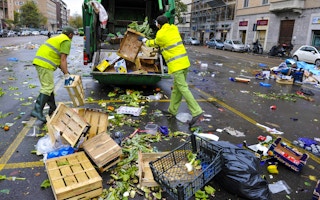Sir John Beddington, the UK government’s chief scientic advisor, suggested that mankind is facing a perfect storm.
To continue reading, subscribe to Eco‑Business.
There's something for everyone. We offer a range of subscription plans.
- Access our stories and receive our Insights Weekly newsletter with the free EB Member plan.
- Unlock unlimited access to our content and archive with EB Circle.
- Publish your content with EB Premium.
The human population is expected to reach almost 10 billion later this century and this growth in population means growth in demand for basics such as food, water and energy.
The fundamental question of our age is therefore: how can we feed a growing population and meet our need for water and energy, while also trying to limit the worst effects of climate change?
That is the perfect storm.
If we are to weaken the storm before it arrives, or at the very least find ways to weather it, then I believe we must address post-harvest food loss.
We live in an age which focuses heavily upon production. Governments, companies and academics spend vast research budgets in an attempt to increase yields and generate more energy.
But I argue that we must do things differently. We must utilise our resources more efficiently and effectively. Above all, we must eliminate waste. That may not be the prevailing wisdom but it is common sense. And post-harvest loss is central to that objective.
Yes, we need to increase food production. But to grow more food will place an increasing strain on agricultural land; more and more water will be used for food production; and the use of fertilizers and pesticides will increase. That cannot be sustainable indefinitely.
But addressing post harvest food loss has an almost wholly positive impact. Addressing post harvest food loss is a key to global sustainability.
I’m not calling for complex and controversial advances in micro-biology or advocating development of exotic materials. And I’m not suggesting a radical rethink of economic systems and structures. I think we just need more cold.
I think we can have a huge impact on food loss using conventional, established and well understood technology.
A key to addressing post-harvest food loss is the humble refrigerator. It’s a concept which has been around for hundreds of years. It’s not rocket science. But once again, it is common sense.
Establishing comprehensive cold chains of refrigerated processing, storage and distribution helps to substantially improve the usable life of food. And if done properly, it helps to ensure that the value of food is maintained from the moment it’s harvested to the moment it’s eaten.
The role of cold chains
In the west, we accept that there is a seamless network of refrigerated processing, storage, distribution and retail that takes food from the farmer’s field to our plates. Not only does it help to eliminate food loss and food wastage, but it also ensures that public safety is not compromised by food which has been allowed to degrade.
But such coordinated cold chains are not universal. Cold – or to be more precise, the lack of cold – is the Achilles’ heel of the world’s developing economies. Where cold chains are either non existent or incomplete, 200 million tonnes of food are lost every year.
In Tanzania, for example, 25 per cent of all milk production is wasted because it has deteriorated to such a degree that it cannot be sold. 97 per cent of the meat produced in the country is sold warm, having never been refrigerated.
The result is hampered development, increased poverty and greater hunger.
And it begs the question, why is 95 per cent of global research and development funding associated with food channelled towards increasing yields? When it could be focused on reducing food losses and in particular, establishing effective cold infrastructure.
Were this to happen; wastage could be reduced; price pressure diminished; and consumption of water and energy slashed.
Cold chains would help to give some shelter from the impending perfect storm.
But the question is, can this massive expansion in cooling infrastructure be delivered without having a detrimental impact on the environment?
I believe that it can but we urgently need to leapfrog the dirty, inefficient, fossil fuelled technologies of the past – and establish new cold chains built on efficient and environmentally conscious foundations. We need to ‘do cold smarter’.
I’m pleased to say that change is already beginning to occur, particularly in rapidly growing economies. China has recognised the essential role of cold in developing food security and a sustainable future.
In China fridge ownership amongst urban households has risen from only 7 per cent to more than 95 per cent today. Simultaneously cold storage capacity soared from just 250 million cubic feet to more than 2 billion in only three years.
The growth is continuing, with China’s cold chain industry reportedly expanding by 25 per cent per year. And China has recently set new legal requirements for cold chain for meat, fish and vegetables.
The lack of a complete cold chain, even diminishes the prospects of achieving higher yields. Farming communities will only produce more food if they can be convinced that they can sell it.
A study by Cornell University found that investment in infrastructure can enable a substantial reduction in post harvest losses, which in turn helps to increase availability, reduce prices and improve economic returns.
When the world meets in Paris shortly to discuss how we can avoid environmental catastrophe, and it begins horse trading about who should cut their emissions fastest, delegates should commit to address food waste. It’s unnecessary. It’s hugely inefficient. And it has to stop!
Out-dated, polluting technology
The problem with existing cold chain technology is that it relies far too heavily on out dated, fossil fuelled, inefficient and polluting technology.
Take the modest transport refrigeration unit as an example. They are seemingly innocuous little white boxes that sit on top of refrigerated trucks and provide refrigeration for the vehicle.
But because transport refrigeration units have never been effectively regulated, they continue to rely on inefficient and polluting diesel engines. As a result, one transport refrigeration unit can emit much much more pollution than a far larger diesel engine on a truck.
In fact, transport refrigeration units can emit 29 times as much particulate matter and 6 times as much NOx as a modern truck engine. That’s despite the fact that a truck engine is many many times more powerful!
And diesel refrigeration units emit significant amounts of CO2, which undermines the positive climate effect which can be achieved by establishing a cold chain in the first place.
When you start to consider the cumulative effect, the problem begins to get frightening.
That’s why I’m demanding a change in strategy. Why I’m calling for clean cold.
There is a huge potential for a new ‘cold economy’ to emerge, which will bring with it cutting-edge technologies, resource efficient systems; and innovative services. Together, these will have a significant, positive impact on food loss; on the lives of farming communities; and on the environment.
The world is beginning to recognise the scale of the storm which is coming our way. I hope leaders will begin to see that food loss is at the very heart of that storm.
We could address hunger simply by producing more. But in so doing, we would exacerbate the problems of water, energy and climate change.
We need an alternative approach. We must tackle waste. And I believe cold is central to that ambition.
But again, we face a choice. Do we accept old polluting cold chain infrastructure? Or do we look to the future and begin to do cold smarter? There can only be one answer.
To establish new cold chain infrastructure based on diesel would help us to win the fight against food loss. But it would be a Pyrrhic victory at best. Ultimately we would lose the war against pollution and environmental degradation.
Globally we have the capacity to weather the perfect storm and to come out the other side stronger, with better infrastructure and more sustainable systems. We just need to make some sensible choices. In so doing, we can make the world a cleaner and cooler place.
Professor Toby Peters is chief executive of Dearman and Chair in Power and Cold Economy, Birmingham Energy Institute, University of Birmingham. His full speech, delivered at the First International Congress On Postharvest Loss Prevention at Rome in October 2015, can be read here.









